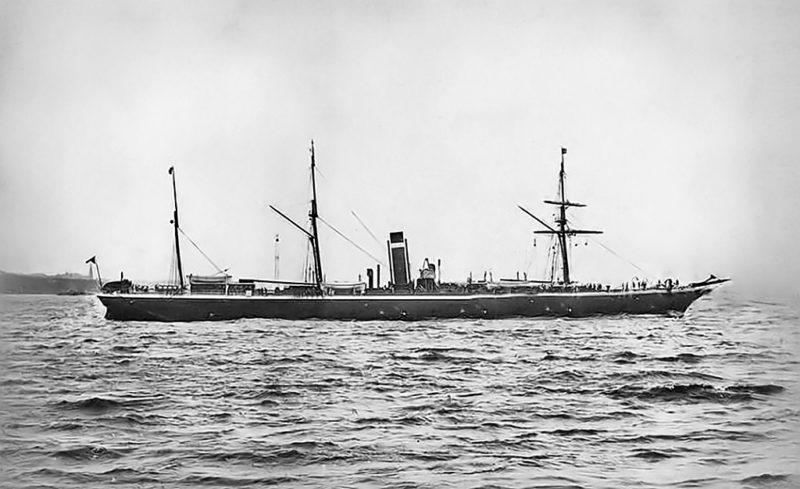
The Allan Line of shipowners was founded by Alexander (Sandy) Allan, born on 26th February 1780 at the Fairlie Estate at Dundonald in Ayrshire as the third son of James Allan, a carpenter and his wife Jean Brown. His mother was the youngest sister of Agnes (Brown) Burns, the mother of Sandy’s famous first cousin, Robert Burns, the Scottish bard, whose family also worked on the Fairlie Estate, which lies a dozen miles inland from the coast between Troon and Irvine. In the summer of 1786, Robert Burns stayed at their cottage to avoid a writ from James Armour in consequence of his relationship with Jean Armour. The most famous works of Robert Burns are Auld Lang Syne, Scots Wa Hae, Comin’ through the Rye, the Banks of Doon and Tam O’ Shanter. Sandy Allan was apprenticed to a shoemaker in Kilmarnock, but quit in order to sail from Saltcoats (Ardrossan) as Mate, Master and later part owner of a sailing ship.
In 1806, Sandy Allan married Jean Crawford (1782-1856) and they had five sons, all of whom played a major part in the Allan Line shipping business. Sandy Allan founded the Allan Line of Sailing Ships in 1819 with regular sailings between Greenock and Quebec as Master of the wooden brigantine Jean, built at Irvine on dimensions of length 76.8 feet, moulded beam 22.6 feet, and depth of 13.4 feet. These sailings began on 9th June 1819, with the Allan family later beginning the Allan Line of Steamships in 1854 to give almost one hundred continuous years of shipowning until 1916, when the line was taken over by Canadian Pacific Steamships. The sailings of the brigantine were fitted in on the St. Lawrence between the Spring and Autumn as the ice prevented navigation for at least four months of winter. Cargo outward was coal, iron, herrings, sugar, spices and general cargo, and homeward Canadian supplies of timber, wheat, peas, flour, potash and general cargo were purchased and sold to merchants in Glasgow and throughout Scotland.
The five sons of Alexander (Sandy) Allan and his wife Jean Allan were:-
- James Allan (1808-1880), who joined in the management of the Allan Line of Sailing Ships, and was joined later by his younger brother Alexander as J. & A. Allan.
- Hugh Allan (1810-1882), who was settled by his father in Montreal at the early age of 16 years, working for a large shipbuilding company in Montreal, and with his younger brother Andrew in 1854 formed the Montreal Ocean Steam Ship Company and a number of friends, and more commonly known as the Allan Line of Steamships to Canada. He quickly settled into Montreal life, later owning a large mansion in the Golden Square Mile area of the city, with reminders of home in Scotland from the many street signs and carved stone faces of the Scottish bard Robert Burns, the first cousin of his father. He was later knighted for services to Canadian financial and shipping industries, having secured the contract for the building of the Canadian Pacific Railway in 1871, but the ‘Pacific Political Scandal’ of 1873 led to its cancellation.
- Bryce Allan (1814-1874) became the manager of the Branch Office at Liverpool.
- Andrew Allan (1822-1901) began as a manager in the Glasgow office and later joined with his elder brother Hugh to form the Montreal Ocean Steam Ship Company.
- Alexander Allan (1825-1892) began as a manager in the Glasgow office in the management of the Allan Line of Sailing Ships, and the managers were later styled as J. & A. Allan with his elder brother James.
THE ALLAN LINE OF SAILING SHIPS
Capt. Sandy Allan soon bought out his co-owners of the brig Jean, with Greenock as the outward port of the line, and he moved his family to Greenock in 1824. The second ship of the line was the twin masted wooden brig Favourite of 296 grt and built in 1825 at Montreal and commanded by Capt. Sandy Allan. The third ship of the line was the wooden ship Canada of 330 grt built in 1831 as the first fully rigged Allan Line sailing ship by Robert Steele & Sons Ltd. of Greenock. She was commanded by Capt. Sandy Allan while James Allan succeeded him as Master of Favourite.
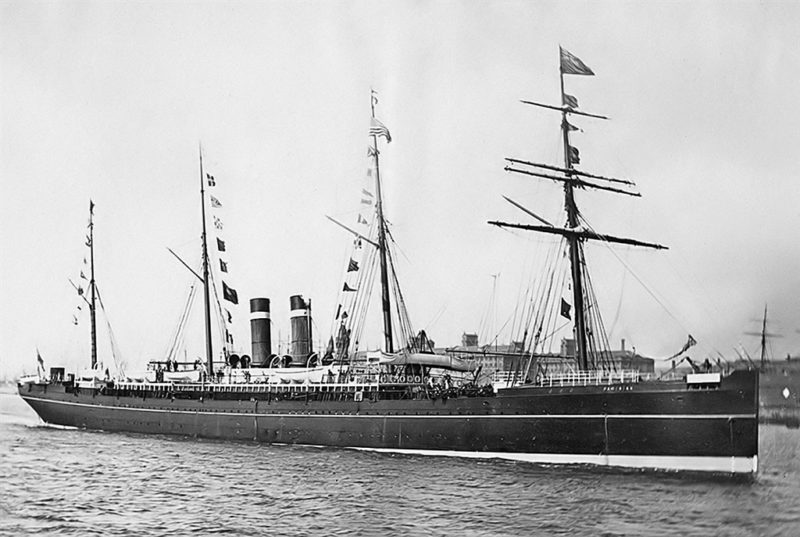
A total of over twenty wooden hulled brigs and barques up to 800 grt were traded by the five Allan brothers between 1819 and 1854, with their father, Capt. Sandy Allan, having retired from active seafaring in 1839, although he kept a close watch over the affairs of the company until his death in 1854. These sailing ships traded mostly from Glasgow and Liverpool to Quebec and Montreal as well as to the Caribbean and South America as far as the Plate during the iced-up St. Lawrence in the winter. They included Brilliant (1834), Thistle (1836), Glasgow (1836), Arabian (1837), Favourite (2) of 1839, Brunette (1840), Blonde (1840), Thalia (1840), Caledonia (1841), Albion (1845), Britannia (1845), Polly (1845), Montreal (1848), Marion (1848), Toronto (1849), Catherine (1850), Ottawa (1851), Harlequin (1851), St. Lawrence (1852), Cairngorm (1853), Mohawk (1854) and Cherokee (1854). Arabian of 1837 was a sister of Canada of 1831, both built by the Glasgow yard of Robert Steel & Company of Glasgow, and was commanded by James Allan on her maiden voyage in July 1837. She was the first Allan Line ship to load at Glasgow in 1838, which became the Scottish terminal port of the Allan Line from that date.
Steamships were used to the St. Lawrence after 1854 from Glasgow and Liverpool after the Montreal Ocean Steam Ship Company was formed by Hugh Allan and Andrew Allan. The Allan Line of Sailing Ships continued to trade until 1896 under the management of James Allan and Alexander Allan, under the style of J. & A. Allan of Great Clyde Street in Glasgow. Larger three and four masted barques of over 1,000 grt were employed on worldwide trades including to India, the Far East, Pacific West Coast of the U.S.A. and Canada, the Caribbean and South America, with five sailing schooners of 220 grt owned in the Plate estuary as lighters to unload the general cargo that arrived from Glasgow, and bring down parcels of grain from the River Parana to form the homeward cargo.
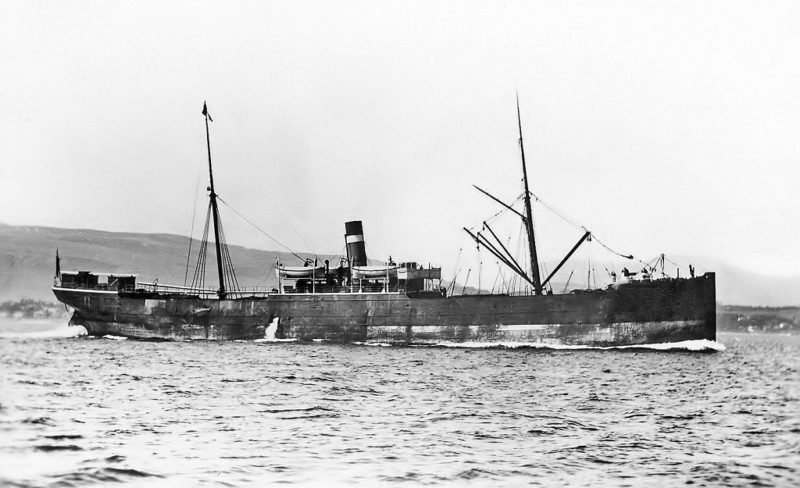
These big barques included Chippewa of 1,096 grt and City of Montreal of 1,187 grt, both built in 1863, Revanscrag of 1,263 grt built in 1866, Abeona of 1,004 grt built in 1867, Pomona of 1,252 grt built in 1867, Strathblane of 1,440 grt built in 1868, Minerva of 1,365 grt built in 1868, Strathearn of 1,784 grt built in 1871, Glenmorag of 1,648 grt built in 1876, Glenfinnart of 1,601 grt built in 1876 by Barclay, Curle & Company, Glendaruel of 1,840 grt built in 1876, Romsdal of 1,887 grt built in 1877, Ardmillan of 1,729 grt built in 1878, Glencairn of 1,621 grt built in 1878, and Dunbritton of 1,536 grt purchased in 1883 having been built for J. H. Watt & Sons of Glasgow in 1875. Glenmorag was the last Allan Line sailing ship in service in the first quarter of 1896, when she was sold to new owners and lost in April 1896 to the north of the Columbia River on the west coast of the U.S.A. after a grounding. The big Allan three masted sister iron sailing ships Gleniffer and Glenbervie of 1,576 grt were built in 1866 at Glasgow by Barclay, Curle & Company and Charles Connell & Sons on dimensions of 195.0 feet by 31.5 feet by 21.0 feet. They each made at least four voyages across the Atlantic in the ‘open’ season of 1871 to Montreal, and were re-rigged as barques in 1881 and sold in the early 1890s to Glasgow owners, with Glenbervie ashore at Lowland Point near the Manacles at Coverack in Cornwall on 13th January 1902, becoming a total loss.
Strathearn gained a reputation for fast sailing in heavy weather, regularly making the St. Lawrence in ten days from Glasgow, before she was sold to the Schramm Brothers of Hamburg and renamed Henriette. Strathblane was also traded to the west coast of the U.S.A. for timber and was lost on 3rd November 1891 when she stranded ten miles north of the mouth of the Columbia River and was lost. Minerva was wrecked in 1871, Glenfinnart went missing after contact was lost after 27th September 1890 in the South Atlantic on a long voyage via the Horn to San Francisco from Glasgow, Glencairn was sold to Thomas Law of Glasgow for further trading in 1895 and was lost off the Horn near Cabo San Paulo on 25th July 1907, Glendaruel sailed from Hull on 4th October 1888 for Rangoon and disappeared after last being heard of on 11th November 1888, and Chippewa was abandoned in the western part of the Bay of Biscay on 7th March 1892 and lost.
Three big barques were sold for further trading to Andrew Weir & Company of Glasgow, who continued to trade barques alongside steamers as was the case with the Allan Line brothers. Abeona of 1,004 grt was sold to Andrew Weir & Company in 1888, and was lost when wrecked on 4th September 1900 on Thunderbolt Reef, Cape Recife while on a voyage from Cardiff to Algoa with coal. Pomona of 1,252 grt was sold to Andrew Weir & Company in 1889 and was abandoned off Portugal in position 39°46′ North, 15°48′ West on 9th December 1902 while on a voyage from London to Algoa Bay with general cargo. Dunbritton of 1,536 grt was sold to Andrew Weir & Company in 1891 and foundered in the North Sea on 4th February 1906 while on a voyage from Hamburg and Leith to Honolulu with general cargo.
Big four and five masted barques e.g. France II of 5,633 grt built in 1911 by the Chantiers & Ateliers de la Gironde at Bordeaux continued to form a major part of the world fleet until after World War I. France II with a big crew of 50 men was at anchor and out of service in July 1922 when she drifted onto a reef in New Caledonia and became a total loss. Sailing ships continued to be used in the inter-war years in the Australian grain trades by Capt. Ericson of Mariehamn in the Aland Islands of Finland, and by the big ‘Flying P’ barques of the Laeisz Line of Germany until the end of the 1950s decade.
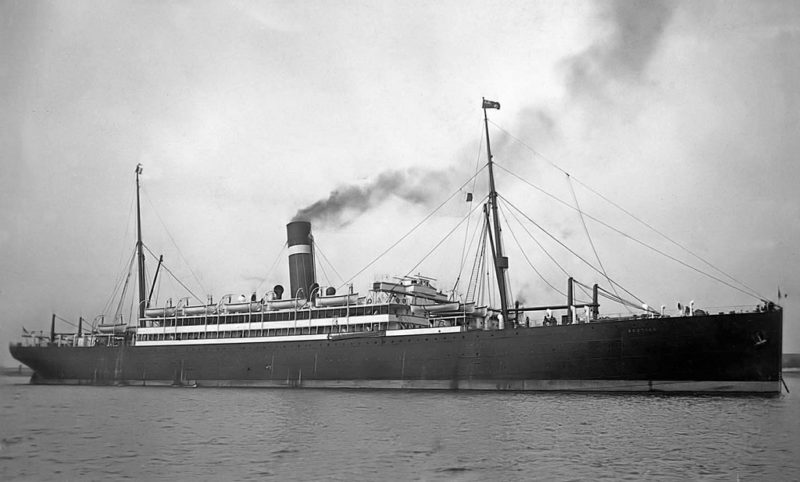
MONTREAL OCEAN STEAM SHIP CO. (ALLAN LINE of STEAMSHIPS)
Hugh Allan played the dominant role in the formation of this company with his younger brother Andrew at Glasgow and their friends in 1854. Canadian of 1,873 grt on dimensions of 278.0 feet by 34.0 feet by 23.5 feet was their first steamer, completed at the Dumbarton yard of William Denny. She switched from Quebec and Montreal as terminal ports to Portland (Maine) in winter, from where good rail connections ran to Montreal. The sisters Indian and North American followed in 1855 from the Denny yard, but on the outbreak of the Crimean War this pair were taken over by the British Government as transports, with the St. Lawrence service suspended for one year. Allan Line funnel colours were red with a black top and a white central band, hulls were black with a red waterline, the fo’c’stle, bridge and poop were white and major deckhouses were white, masts were buff and lifeboats were white. Passengers and mail in 1855 bound for Canada were transported by Collins Line vessels to New York, and then overland to Canadian cities.
When the Allan Line service resumed in 1856, it was with a full mail subsidy of £25,000 per year, increased to £42,000 for the year of 1857 from the Canadian Post Office, as it was convinced that there were enough letters and parcels going between Canada and the U.K. to warrant the contract. This mail contract was actually the second one issued by the Canadian Post Office, the first had been made in 1853 to the Canadian Steam Navigation Company, which was newly formed to expedite this contract. However, this shipping line was declared bankrupt in March 1855, having used seven ships of very varying quality during that time on the North Atlantic, consisting of four chartered ships and with the remaining three requisitioned for Crimean War duty as transports.
However, all letters at this time needed to be sent in duplicate as there was a very high attrition rate of the first fourteen Allan Line steam ships in service. The full power of the winds, currents and tides on the St. Lawrence coupled with insidious fogs, a four month ‘closed season’ due to six feet of ice, and the complete absence of any lighthouses, and the inadequacy of the Coastguard meant that eleven of the first fourteen Allan Line steamers were lost, a number of these with a very high loss of life. The passenger complement varied from 320 to 450, and the crew varied around 70 in number. This is shown in the following table:-
Name Built Date Details Lives lost
- CANADIAN 1854 1.6.1857 Wrecked near Quebec 20
- INDIAN 1855 21.11.1859 Wrecked at Cape Race 27
- NORTH AMERICAN 1856 1866 Damaged by stranding, repaired
- ANGLO-SAXON 1856 27.4.1863 Wrecked at Cape Race 238
- NOVA SCOTIAN 1858 Survived 16 years of sailings –
- NORTH BRITON 1858 5.11.1861 Wrecked at Paraquet Isle –
- HUNGARIAN 1859 20.2.1860 Wrecked off Sable Island 237
- BOHEMIAN 1859 22.2.1864 Wrecked Portland (Maine) 20
- CANADIAN (2) 1860 4.6.1861 Wrecked Belle Ilse Strait 35
- JURA 1860 3.11.1864 Wrecked at Mersey –
- HIBERNIAN 1861 Survived 39 years of sailings –
- NORWEGIAN 1861 14.6.1863 Wrecked St. Paul’s Island –
- SAINT ANDREW 1861 Survived 42 years of sailings –
- SAINT GEORGE 1861 29.4.1869 Wrecked on Seal Island –
The three masted steam ship Hungarian of 2,190 grt was completed by William Denny & Brothers at Dumbarton in May 1859 and had a very brief but active career of only nine months. She sighted a vessel in distress on 9th November 1859 in high seas on the edge of the Newfoundland Banks. A crew of seven men pulled a lifeboat to her, the British schooner John Martin, and rescued 43 people including 23 women and children. The Chief Officer in the lifeboat was knocked overboard during the rescue and could not swim, but hauled himself back into the boat by means of a rope. A silver cup was awarded to the lifeboat crew as well as other gifts, but Hungarian did not survive a grounding on 19th February 1860 on Cape Ledge on the west side of Cape Sable (NS). She was on a voyage from Liverpool via Queenstown to Portland (Maine) and sadly all of her crew of 73 were lost.
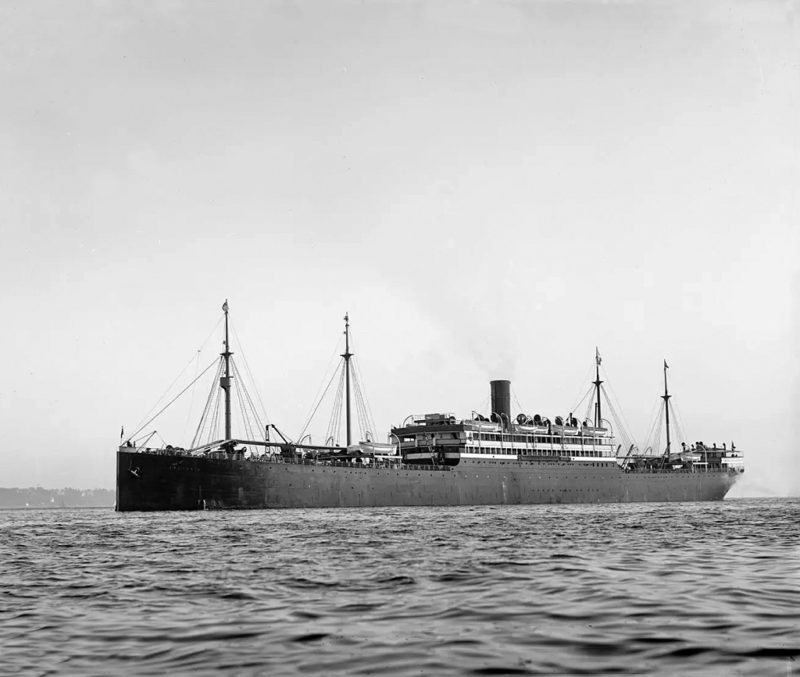
Compare the very high attrition rate of Allan Line ships to Canada with the very low attrition rate of the first fourteen Cunard passenger ships to New York from the first sailing of their Britannia in 1840, with only one ship lost, Columbia of 1841, at Halifax (NS) on 2nd July 1843, wrecked on Devil’s Limb Reef at Seal Island (NS) without loss of life. The Britannia class of six ships and the succeeding America class had gross tonnages varying from 1,150 to over 3,000 and carried 115 to 300 passengers. The Cunard Line steamer Damascus of 1,213 grt and built in 1856 was chartered to Allan Line in 1862, and purchased in 1865.
Fortunately, on the St. Lawrence as each year passed, more control of the powerful forces of nature could be made by the Allan Line steam ships, together with the installation of numerous navigation lights and other badly needed safety features, and meant that attrition rates came down quickly. Where there had previously been no help whatsoever for all of the drowning passengers and crew, there were now several means of rescue from the shore. Letters were no longer needed to be sent in duplicate for fear of their loss.
In 1861/62, Allan Line chartered two ships for their Canadian service, the former sailing ship John Bell of 1,101 grt and renamed Saint Patrick in 1863, and the former Cunard Line steamer Damascus of 1,213 grt and renamed Corinthian in 1862. These were stop gaps to replace vessels lost by maritime causes. The building of new liners then resumed with Peruvian of 2,549 grt in 1864 from the yard of Robert Steel & Company with very good accommodation for 100 First Class passengers and 300 in Third class and steerage. She had an unfortunate debut to her career, being stuck on the launching ramp during the launching ceremony, and then being badly damaged by fire during her outfitting, delaying her entry into service by six months. She was lengthened by 60 feet in 1874 to 373.1 feet with a new gross tonnage of 3,038 and a more powerful compound steam engine instead of the previous two cylinder inverted one.
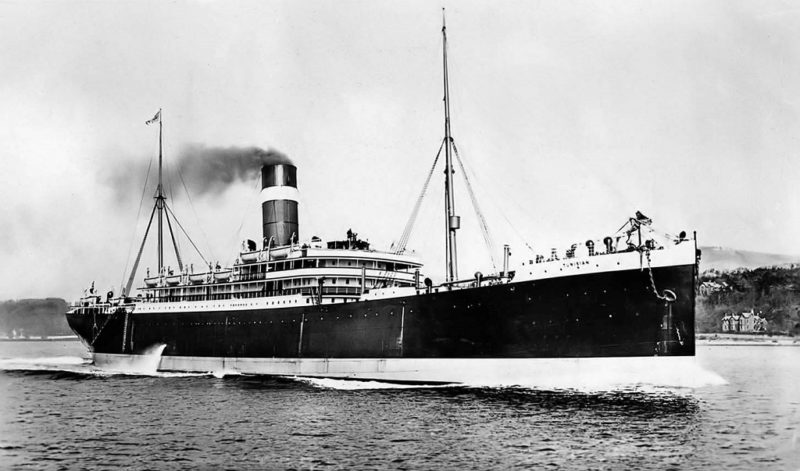
The wooden screw steamer Newfoundland of 919 grt was completed in 1872 at Quebec, with her machinery built at the Ouseburn Engineering Company in Newcastle upon Tyne. She was later re-rigged as a barque for the feeder service from Halifax (NS) to St. John’s (NFLD) until sold in 1902 for use as a sealer. During the decade from 1865 to 1875, fifteen new or second hand Allan Line liners entered service as:-

Name Year in Service Passengers Fate
- MORAVIAN 1864 80 1st, 250 3rd 30.12.1881 Wrecked in Nova Scotia
- NESTORIAN 1866 115 1st, 250 3rd 1897 Broken up at Preston
- AUSTRIAN 1867 115 1st, 250 3rd 1905 Broken up
- BELGIAN 1864 54 1st, 456 3rd Purchased as Hammonia, sold 1873
- PHOENICIAN 1864 30 1st, 300 3rd 1905 Broken up at Genoa
- MANITOBAN 1868 25 1st, 300 3rd 1899 Broken up at Genoa
- GERMANY 1868 50 1st, 400 3rd 12.1872 Lost near Bordeaux, 30 dead
- EUROPEAN 1869 500 in 3 classes Purchased as William Penn, sold 1872
- PRUSSIAN 1869 190 1st, 340 3rd 1898 Broken up at Genoa
- SCANDINAVIAN 1870 100 1st, 350 3rd 1899 Broken up at Genoa
- CASPIAN 1870 80 1st, 400 3rd 1897 Broken up at Genoa
- SARMATIAN 1871 100 1st, 850 3rd 1908 Broken up at Rotterdam
- CIRCASSIAN 1872 100 1st, 850 3rd 1896 Broken up in USSR
- POLYNESIAN 1872 100 1st, 850 3rd 6.9.1909 Wrecked at Cape Race
- SARDINIAN 1875 100 1st, 850 3rd 1917 Taken over by Canadian Pacific
An advertisement appeared in a Trondheim newspaper in Norway in May 1869 and read:-
‘The Allan Line steam ships Norway and Sweden, each of 967 grt, will open and maintain a weekly service from Trondheim to Newcastle upon Tyne with passengers via Christiansund, Aalesund and Bergen. This is intended as a feeder service for the larger Allan Line liners departing from Liverpool and Glasgow. Pyrites from the mines at Ytteroy further down Trondheim fjord is the cargo to be carried to the Tyne. The service also will convey Anchor Line passengers between these ports.’
This arrangement between Allan Line and Anchor Line was not carried out smoothly by the agents of both companies, and was discontinued. The service was changed in 1870 to run from Trondheim to Leith via Christiansund, Aalesund, Bergen and Christiania (Oslo), but reverted to the original Newcastle upon Tyne route in 1871 and 1872, with both vessels sold off at the end of the 1872 summer, and the service was discontinued due to a lack of passengers. Passengers travelled from Newcastle Central Station to Liverpool Lime Street Station to board Transatlantic liners, or to Glasgow Queen Street Station via Edinburgh Waverley Station or Glasgow Central Station via Carlisle Station to board liners for Canada. Richard Solem was the Head Agent at his office in Sondre Gate 25 in Trondheim and sought clients from the Dovrefjell region of Norway and the Jemtland region in Sweden for Allan Line from 1893 until 1916, when Allan Line was taken over by Canadian Pacific Steamships. Most of the Norwegian emigrants boarded liners at Liverpool for Canada, but others boarded liners on the Glasgow to Boston route, or Glasgow to New York route.
The First Class Saloon passenger fares one way across the Atlantic had begun in 1855 at 8 guineas, but had increased by 1879 to First Class Saloon fares from between 12 and 21 guineas, with return tickets at 25 or 30 guineas, and Intermediate (Second) Class fares at 8 guineas one way, and Steerage Class fares at very low rates. Assisted passages to Canada were granted to mechanics, navvies, agricultural and general labourers and their families, and to female domestic servants. The average length of the passage from Glasgow or Liverpool via Belle Isle Strait to Quebec was six or seven days in 1879, while the fastest passage had been made by the steam ship Sardinian in June 1879 from Liverpool to Quebec of 6 days, 23 hours and 30 minutes via Moville (Londonderry), and only 5 days and 20 minutes to Belle Isle Strait. The great beauty of the St. Lawrence river and the Saguenay river, which was passed at the entrance at Tadoussac, was extolled at great length in the publicity brochures in order to attract passengers for the Transatlantic voyage.

MERGER OF ALLAN LINE and STATES LINE
Sir Hugh Allan had died on 9th December, 1882 at the age of 72 years, with his shipping company then the biggest in terms of number of ships on the North Atlantic, with 22 Transatlantic liners and eleven sailing ships. He had also begun in 1876 a new service to Buenos Aires and Montevideo from Glasgow in order to keep his ships employed during the ‘closed’ St. Lawrence in winter. Canadian of 2,911 grt built in 1873 by Thomas Royden & Company at Liverpool took the first sailing in April of that year, with another ship Lucerne of 1,925 grt specially built in 1878 with extra cargo capacity for the route. Most of the fleet of steamers made at least one or more voyages per year on the new South American route, including the new Buenos Ayrean of 4,005 grt, the first Allan Line ship built of steel and with extra capacity for cargo, as well as accommodation for 85 First Class passengers and 800 in Third Class.
Allan Line in the 1880s built the new sister liners Grecian, Hanoverian and Corean of 3,613 grt at the Doxford yard at Pallion in Sunderland, Parisian of 5,359 grt at Robert Napier’s yard in Glasgow, Siberian of 3,904 grt at the Govan Shipbuilding Company yard, and purchased the City of New York of 3,523 grt from Inman Line renamed Norwegian, as well as the purchased Grecian Monarch of 4,364 grt and Assyrian Monarch of 3,317 grt from Monarch Line renamed Pomeranian and Assyrian. In 1905, Parisian collided with the steamer Albano off Halifax (NS), with Albano found to be fully at fault at the subsequent enquiry. She originally had twin funnels, but she was rebuilt in 1899 with one funnel and pole masts without yards and new triple expansion steam engines.
In 1891, Allan Line took over the assets of the British registered but American capitalised States Line for £72,000 with seven ships. Their route was from Glasgow to New York, but since Allan Line needed only five ships for this route, one was immediately sold on. The remaining six were:-
- State of Pennsylvania sold for further service in 1893 to Turkish owners
- State of Indiana sold for further service in 1893 to Turkish owners
- State of Georgia sold for further service to Aberdeen Line in 1893
- State of Nevada sold for further service in 1893 to Turkish owners
- State of Nebraska sold for further service in 1893 to Turkish owners
- State of California renamed Californian in 1898 and sold to U.S. owners in 1901
The ‘States’ liners joined five new liners built recently and during that year of 1891 by the yard of D. & W. Henderson in Glasgow as Rosarian, Monte Videan, Brazilian, Mongolian and Numidian. Three were used on the South American service, while Mongolian and Numidian were used to Canada and as troop transports during the Boer Wars of 1899 to 1901. Castillian of 7,441 grt was completed by Workman, Clark & Co. Ltd. in February 1893, but had a very short career being wrecked on the homeward leg of her maiden voyage on 11th March in the Bay of Fundy without loss of life. Purchased ships at this time included Turanian, Roumanian, and Livonian from Twin Screw Line, Orcadian from other Glasgow owners, Gallia from Cunard Line, which stranded at Sorel Point opposite Quebec on her maiden voyage for Allan Line and after salvage she was broken up.
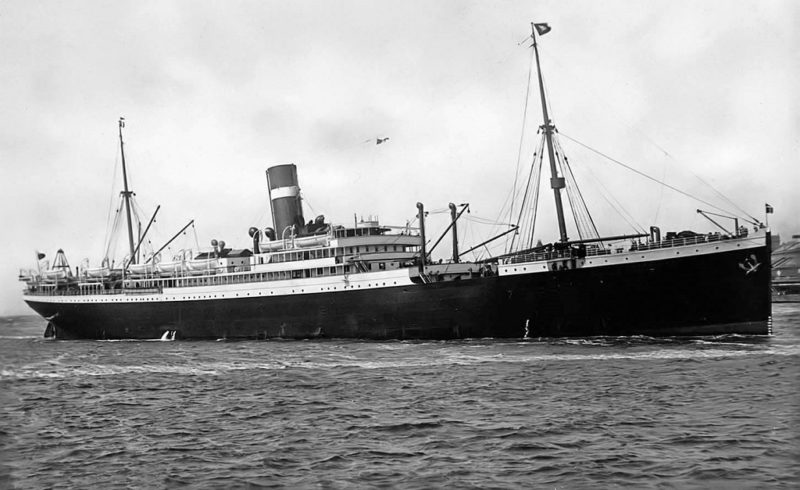
At the turn of the new century in 1900, Allan Line had a big fleet of 33 ships in service, named Assyrian, Austrian, Bavarian, Brazilian, Buenos Ayrean, Californian, Canadian, Carthaginian, Corean, Corinthian, Grecian, Hibernian, Laurentian, Livonian, Mongolian, Monte Videan, Norwegian, Numidian, Ontarian, Orcadian, Parisian, Peruvian, Phoenician, Pomeranian, Pretorian, Rosarian, Sardinian, Sarmatian, Siberian, Sicilian, Turanian, Tunisian, and Waldensian.
Bavarian was also used as a Boer War troop transport, but had the misfortune to run aground on 3rd November 1905 on Wye Rock near Montreal within sight of her berth at Montreal and she broke in two and was broken up where she lay, no lives were lost. Allan Line began to build much bigger liners from the turn of the century, over 10,000 grt, as their competitors of the International Mercantile Marine Company, formed in 1902, included White Star Line and Dominion Line, while Canadian Pacific Steamships purchased the fifteen ship North Atlantic fleet of Elder Dempster for £1.418 million in 1903. These eleven much bigger Allan Line liners with three classes of accommodation were:-
- Name Year grt Builders 1st/2nd/3rd
- CORSICAN 1907 11,419 Barclay, Curle 208/298/999
- HESPERIAN 1907 10,920 Alexander Stephen 210/250/999
- GRAMPIAN 1907 10,187 Alexander Stephen 210/250/999
- SCANDINAVIAN 1898 12,099 Harland & Wolff, Belfast 200/200/800
- SCOTIAN 1898 10,322 Harland & Wolff, Belfast 200/175/999
- BAVARIAN 1899 10,376 William Denny 200/175/999
- TUNISIAN 1900 10,576 Alexander Stephen 240/220/999
- VICTORIAN 1904 10,635 Workman, Clark, Belfast 470/240/940
- VIRGINIAN 1904 10,757 Alexander Stephen 470/240/940
- ALSATIAN 1914 18,481 William Beardmore 287/504/828
- CALGARIAN 1914 17,515 Fairfield Shipbuilders 80/500/900
Corsican made her maiden voyage on 31st October 1907 between Liverpool and St. John (NB), and was then long term chartered by the Canadian Pacific Railway for over six years, until she began her last voyage between Liverpool and St. John (NB) in January 1914. She was then taken on a Canadian Government contract to carry troops from August 1914 to Le Havre, Alexandria and Bombay until she made her first commercial voyage between Glasgow and Quebec and Montreal on 24th August 1918.
Scandinavian was purchased in 1912 from White Star Line as Romanic, but had been built by Harland & Wolff Ltd. at Belfast as New England for Dominion Line, with three decks for passengers. She was twin screw and powered by twin triple expansion steam engines to give a service speed of 15 knots. She made her first sailing for White Star Line on 19th November 1903 from Liverpool to Boston. She was purchased by Allan Line in January 1912 and with her accommodation refitted she began on the winter service from Glasgow to Halifax (NS) and Boston, and switched to the summer service from Glasgow to Quebec and New York. She transported Canadian troops from 1914 to England, and operated under the Liner Requisition Scheme during 1917/18. She returned to Allan Line services to Quebec, Montreal, Halifax (NS) and New York after the war but was laid up at Falmouth in July 1922 and broken up at Hamburg in October 1923.
The similarly sized Scotian was purchased in 1911 from Holland America Line as Statendam. The turbine powered Victorian and Virginian had dimensions of overall length of 520.0 feet, moulded beam of 60.4 feet, and moulded depth of 38.0 feet with a loaded draft of 27.0 feet. The sisters had four decks for passengers with the Promenade and Bridge Decks on top for First Class passengers, and the Main and Upper Decks for Second Class and Third Class passengers. They had Orlop Decks down below fore and aft of her machinery spaces and her holds could carry 8,000 tonnes of cargo including refrigerated space for perishable cargo.
The mail contract had been renewed in 1904, but from that date on a ‘subsidy per ship for number of round voyages completed’. These were £2,000 for Virginian and Victorian, £1,000 for Bavarian and Tunisian, and £500 for all of the remaining ships. Virginian and Victorian were triple screw turbine powered and the first turbine liners on the North Atlantic route, and at service speeds of just over 18 knots and maximum speeds of 19.5 knots on trials, and were immediately record breakers. Victorian ran aground on 1st September 1905 at Cape St. Charles in Labrador on an eastbound crossing, with dense smoke from forest fires impeding her navigation. She had 19 feet of water in her number two hold, her 350 passengers were taken off and transferred to Bavarian a week later, and her mails were taken to New York and then sent eastbound. The pair were fully equipped with Marconi wireless telegraphy in 1912, and this came in useful on Victorian on 15th April 1912 during the sinking of the Titanic, her position being over 300 nautical miles astern of the casualty, with the Cunard liner Carpathia handling most of the wireless traffic. Virginian made her maiden voyage on 6th April 1905 from Liverpool to St. John (NB), and then switched to the Liverpool to Quebec and Montreal route. Armed Merchant Cruiser duties during World War I to the 10th Cruiser Squadron occupied both of the sisters.
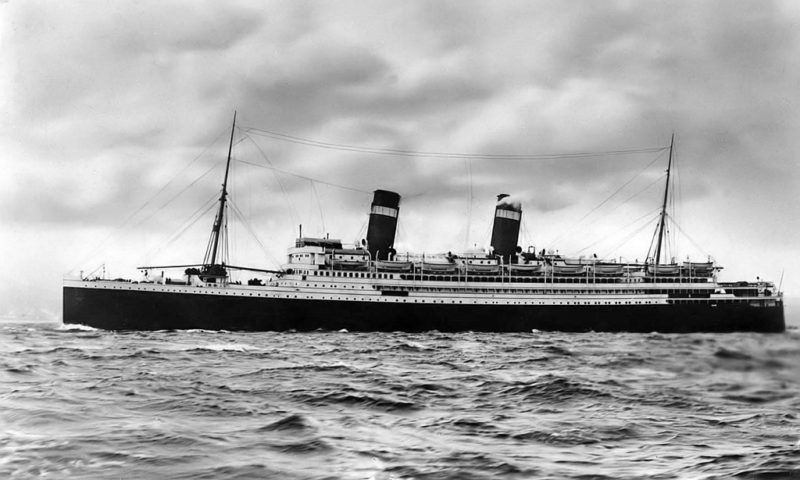
THE FINAL DECADE and SWANSONG
The Glasgow to New York services were withdrawn in 1905 in order to concentrate on the Glasgow to Quebec and Montreal service. The South American River Plate service was suspended and withdrawn in 1913, with Donaldson Line of Glasgow acquiring the goodwill of the trade. The twin funnelled Alsatian and Calgarian, sister liners of 1913, were given cruiser sterns and quadruple screws powered by four steam turbines, in consequence they were very fast at 20 knots but heavy on fuel.
The Allan Line fleet numbered twenty liners on the outbreak of war in August 1914, with Alsatian and Calgarian immediately requisitioned as Armed Merchant Cruisers in the 10th Cruiser Squadron. Livonian, Mongolian and Numidian were purchased by the Admiralty for use as block ships at Scapa Flow. Hesperian was torpedoed and sunk by a U-boat on 4th September 1914 off the Fastnet, 32 lives were lost.
Canadian Pacific Steamships wished to replace the fifteen liners they had purchased from Elder Dempster with more modern liners, and Allan Line was the perfect fit and in use on the same St. Lawrence services. Allan Line had disposed of surplus assets and ships, closed down the Plate and other non-American services, and joint departments had opened in both Liverpool and Montreal.
The Ottawa Government had given the Canadian Pacific Railway the right to operate ships independently of the railway undertaking on 16th March 1915, and thus Canadian Pacific Steamships Ltd. was formed to own its vessels. Another new company called Canadian Pacific Ocean Services Ltd., was formed at the start of 1916 to acquire both the Allan Line fleet and the Canadian Pacific Steamships ‘Empress’ fleet. Finally, on Vesting Day of 16th July 1916, all management and control was merged and the remaining seventeen Allan Line liners were taken over. Thus, ended the career of the one of the greatest passenger and cargo liner companies on the North Atlantic.
The new merged Head Office was at 8 Waterloo Place in London, and press comment was not unfavourable and saw it as ‘the big ally absorbing its little brother’. Due to wartime restrictions on the renaming of ships, the transfer of the grey painted ships went almost unnoticed by the public, indeed some ships on Government requisition did not transfer into Canadian Pacific Ocean Services Ltd. until after the war was over. The fine reputation and Allan Line names were retained for a few more years. The new Canadian Pacific names were as follows:-
- ALSATIAN – Renamed Empress of France in 1919
- CALGARIAN – 1.3.1914 – Torpedoed and sunk by U-19 off Rathlin Island while guarding a convoy of 40 ships, 49 lives lost.
- CORINTHIAN – 14.12.1918 – Wrecked in the Bay of Fundy on Brier Island, total loss.
- CORSICAN – Renamed Marvale in 1922, 21.5.1923 Wrecked on Freel Rock, Cape Pine (NFLD)
- GRAMPIAN – Not renamed, burnt out while refitting at Antwerp in 3.1921
- IONIAN – 20.10.1917 – Hit a mine and sank off St. Govan’s Head while sailing from Liverpool to Plymouth, 7 lives lost.
- MONGOLIAN – 21.7.1918 – Torpedoed and sunk off Filey Brig, 36 lives lost.
- POMERANIAN – 15.4.1918 – Torpedoed and sunk off Portland Bill while on a voyage from London to Saint John (NB), 55 lost.
- PRETORIAN – Laid up in the Gareloch 3.1922 unnamed, broken up at Liverpool in 1926
- SARDINIAN – Hulked at Vigo in Spain in 1920
- SCANDINAVIAN – Laid up at Falmouth 7.1922, broken up at Hamburg in 1923
- SCOTIAN – Renamed Marglen in 1923, broken up at Genoa in 1928
- SICILIAN – Renamed Bruton in 1923, broken up in Italy in 1925
- TUNISIAN – Renamed Marburn in 1922, broken up in Genoa in 1928
- VICTORIAN – Renamed Marloch in 1922, broken up at Pembroke Dock in 1929
- VIRGINIAN – 2.1920 – Sold to Swedish Lloyd Line renamed Drottningholm. 1948 renamed Brasil, 1951 renamed Homeland. 1955 Broken up at Trieste after a fifty year career.
POSTSCRIPT
Today, there is a last floating link in existence with the great Allan Line liners in the Musee Maritime de Quebec. The tug Helena of 299 grt, built in 1907 by the local Collingwood Shipbuilding Company, began its career in the St. Lawrence and Great Lakes areas and most probably berthed Allan Line ships. She was owned by the Canadian Government for many years, and her steam engine was replaced with a more powerful diesel engine in the 1950s, and she was renamed Helen MB in 1956. McAllister Towing Ltd. of New York brought the tug to Montreal in the 1960s and renamed her Daniel McAllister until she finished her long towing career at Montreal in the late 1980s. She was acquired by the Musee Maritime de Quebec in 1997, and her hull, bridge and superstructure were completely restored to the black hull and yellow line, red bridge and superstructure, and red funnel with a black top and with two white bands, the colours of the McAllister Towing Ltd.

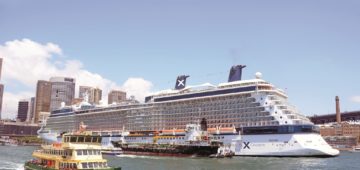



Comments
Sorry, comments are closed for this item